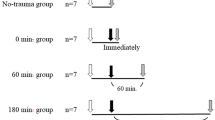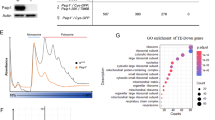Abstract
Plasminogen activator inhibitor-1 (PAI-1) is unique among the serine proteinase inhibitors (serpins) in that it can adopt at least three different conformations (active, substrate and latent). We report the X-ray structure of a cleaved substrate variant of human PAI-1, which has a new β-strand s4A formed by insertion of the amino-terminal portion of the reactive-site loop into β-sheet A subsequent to cleavage. This is in contrast to the previous suggestion that the non-inhibitory function of substrate-type serpins is mainly due to an inability of the reactive-site loop to adopt this conformation. Comparison with the structure of latent PAI-1 provides insights into the molecular determinants responsible for the transition of the stressed active conformation to the thermostable latent conformation.
This is a preview of subscription content, access via your institution
Access options
Subscribe to this journal
Receive 12 print issues and online access
$259.00 per year
only $21.58 per issue
Buy this article
- Purchase on SpringerLink
- Instant access to full article PDF
Prices may be subject to local taxes which are calculated during checkout
Similar content being viewed by others
References
Pannekoek, H. et al. Endothelial plasminogen activator inhibitor (PAI): a new member of the serpin gene family. EMBO J. 5, 2539–2544 (1986).
Ny, T., Sawdey, M., Lawrence, D., Millan, J.L. & Loskutoff, D.J. Cloning and sequence of a cDNA coding for the human beta-migrating endothelial-cell-type plasminogen activator inhibitor. Proc. natn. Acad. Sci. U.S.A. 83, 6776–6780 (1986).
Ginsburg, D. et al. cDNA cloning of human plasminogen activator inhibitor from endothelial cells. J. clin. Invest. 78, 1673–1680 (1986).
Andreasen, P.A. et al. Plasminogen activator inhibitor type-1 : reactive center and amino-terminal heterogeneity determined by protein and cDNA sequencing. FEBS Lett. 209, 213–218 (1986).
Van Mourik, J.A., Lawrence, D.A. & Loskutoff, D.J. Purification of an inhibitor of plasminogen activator (antiactivator) synthesized by endothelial cells. J. biol. Chem. 259, 14914–14921 (1984).
Sprengers, E.D. & Kluft, C. Plasminogen activator inhibitors. Blood 69, 381–387 (1987).
Alessi, M.C., Declerck, P.J., De Mol, M., Nelles, L. & Collen, D. Purification and characterisation of natural and recombinant human plasminogen activator inhibitor-1 (PAI-1). Eur. J. Biochem. 175, 531–540 (1988).
Loskutoff, D.J., Sawdey, M. & Mimuro, J. Type 1 plasminogen activator inhibitor. Hemostasis and Thrombosis 9, 87–115 (1989).
Danø, K. et al. Plasminogen activators, tissue degradation, and cancer. Adv. Cancer Res. 44, 139–266 (1985).
Huber, R. & Carrell, R.W. Implications of the three-dimensional structure of α1-antitrypsin for structure and function of serpins. Biochemistry 28, 8951–8966 (1989).
Laskowski, M. & Kato, I. Protein inhibitors of proteinases. A. Rev. Biochem. 49, 593–626 (1980).
Stein, P.E. & Chothia, C. Serpin tertiary structure transformation. J. molec. Biol. 221, 615–621 (1991).
Loebermann, H., Tokuoka, R., Deisenhofer, J. & Huber, R. Human α1-proteinase inhibitor. Crystal structure analysis of two crystal modifications, molecular model and preliminary analysis of the implications for function. J. molec. Biol. 177, 531–556 (1984).
Wright, H.T., Qian, H.X. & Huber, R. Crystal structure of plakalbumin, a proteolytically nicked form of ovalbumin. Its relationship to the structure of cleaved α1-proteinase Inhibitor. J. molec. Biol. 213, 513–528 (1990).
Stein, P.E., Tewkesbury, D.A. & Carrell, R.W. Ovalbumin and angiotensinogen lack serpin S-R conformational change. Biochem. J. 262, 661–663 (1989).
Declerck, P.J., De Mol, M., Vaughan, D.E. & Collen, D. Identification of a conformationally distinct form of plasminogen activator inhibitor-1, acting as a non-inhibitory substrate for tissue-type plasminogen activator. J. biol. Chem. 267, 11693–11696 (1992).
Hekman, C.M. & Loskutoff, D.J. Endothelial cells produce a latent inhibitor of plasminogen activators that can be activated by denaturants. J. biol. Chem. 260, 11581–11587 (1985).
Urano, T., Strandberg, L., Johansson, L.B.-A & Ny, T. A substrate-like form of plasminogen activator inhibitor type 1. Conversion between different forms by sodium dodecyl sulphate. Eur. J. Biochem. 209, 985–992 (1992).
Munck, M., Heegaard, C.W. & Andreasen, P.A. Interconversions between active, inert and substrate form of denatured/refolded type 1 plasminogen activator inhibitor. Biochim. biophys. Acta 1202, 29–37 (1993).
Vaughan, D.E., Declerck, P.J., Van Houtte, E., De Mol, M. & Collen, D. Studies of recombinant plasminogen activator inhibitor-1 in rabbits : pharmacokinetics and evidence for reactivation of latent plasminogen activator inhibitor-1 in vivo. Circulation Res. 67, 1281–1286 (1990).
Mottonen, J. et al. Structural basis of latency in plasminogen activator inhibitor-1. Nature 355, 270–273 (1992).
Carrell, R.W., Evans, D.LI. & Stein, P.E. Mobile reactive centre of serpins Nature 353, 576–578 (1991).
Audenaert, A.-M., Knockaert, I., Collen, D. & Declerck, P.J. Conversion of plasminogen activator inhibitor-1 from inhibitor to substrate by point mutations in the reactive-site loop. J. biol. Chem. 269, 19559–19564 (1994).
Perry, D.J., Harper, P.L., Fairham, S., Daly, M. & Carrell, R.W. Antithrombin Cambridge, 384 alanine to Pro: a new variant identified using the polymerase chain reaction. FEBS Lett. 254, 174–176 (1989).
Levy, N.J., Ramesh, N., Cicardi, M., Harrison, R.A. & Davis, A.E. Type II hereditary angioneurotic edema that may result from a single nucleotide change in the codon for alanine-436 in the C1 inhibitor gene. Proc. natn. Acad. Sci. USA 87, 265–268 (1990).
Baumann, U. et al. Crystal structure of cleaved human α1-antichymotrypsin at 2.7 Å resolution and its comparison with other serpins. J. molec. Biol. 218, 595–606 (1991).
Stein, P.E. et al. Crystal structure of ovalbumin as a model for the reactive centre of serpins. Nature 347, 99–102 (1990).
Schulze, A.J. et al. Structural transition of α1-antitrypsin by a peptide sequentially similar to β-strand s4A. Eur. J. Biochem. 194, 51–56 (1990).
Bjork, I., Ylinenjarvi, K., Olson, S.T. & Bock, P.E. Conversion of antithrombin from an inhibitor of thrombin to a substrate with reduced heparin affinity and enhanced conformational stability by binding of a tetradecapeptide corresponding to the P1 to P14 region of the putative reactive bond loop of the inhibitor. J. biol. Chem. 267, 1976–1982 (1992).
Schreuder, H.A. et al. The intact and cleaved human antithrombin III complex as a model for serpin-proteinase interactions. Nature struct. Biol. 1, 48–54 (1994).
Carrell, R.W., Stein, P.E., Fermi, G. & Wardell, M.R. Biological implications of a 3 Å structure of dimeric antithrombin. Structure 2, 257–270 (1994).
Wei, A., Rubin, H., Cooperman, B.S. & Christianson, D.W. Crystal structure of an uncleaved serpin reveals the conformation of an inhibitory reactive loop. Nature struct. Biol. 1, 251–258 (1994).
Aertgeerts, K., De Bondt, H.L., De Ranter, C. & Declerck, P.J. Crystallization and X-ray diffraction data of the cleaved form of plasminogen activator inhibitor-1. Proteins 23, 118–121 (1995).
Holmes, W.E. et al. α2-antiplasmin Enschede: Ala insertion and abolition of plasmin inhibitory activity. Science 238, 209–211 (1987).
Lawrence, D.A., Olson, S.T., Palaniappan, S. & Ginsburg, D. Serpin reactive center loop mobility is required for inhibitor function but not for enzyme recognition. J. biol. Chem. 269, 27657–27662 (1994).
Engh, R.A., Schulze, A.J., Huber, R. & Bode, W. Serpin Structures. Behring Inst. Mitt. 93, 41–62 (1993).
Aertgeerts, K., De Bondt, H.L., De Ranter, C. & Declerck, P.J. A model of the reactive form of plasminogen activator inhibitor-1. J. struct. Biol. 113, 239–245 (1994).
Sancho, E., Tonge, D.W., Hockney, R.C. & Booth, N.A. Purification and characterization of active and stable recombinant plasminogen-activator inhibitor accumulated at high levels in Escherichia coli. Eur. J. Biochem. 224, 125–134 (1994).
Lomas, D.A., Elliott, P.R., Chang, W.-S.W., Wardell, M.R. & Carrell, R.W. Preparation and characterization of latent α1-antitrypsin. J. biol. Chem. 270, 5282–5288 (1995).
Wright, H.T. & Blajchman, M., A Proteolytically cleaved mutant antithrombin-Hamilton has high stability to denaturation characteristics of wild type inhibitor serpins. FEBS lett. 348, 14–16 (1994).
Sancho, E., Declerck, P.J., Price, N.C., Kelly, S.M. & Booth, N.A. Conformational studies on plasminogen activator inhibitor-1 (PAI-1) in active, latent, substrate and cleaved forms. Biochemistry 34, 1064–1069 (1995).
Gettins, P., Patston, P.A. & Schapira, M. The role of conformational change in serpin structure and function. BioEssays 15, 461–467 (1993).
Hood, D.B., Huntington, J.A. & Gettins, P.G.W. α1-Proteinase inhibitor variant T345R. Influence of P14 residue on substrate and inhibitory pathways. Biochemistry 33, 8538–8547 (1994).
Olson, S.T., Stephens, A.W., Hirs, C.H.W., Bock, P.E. & Björk, I. Kinetic characterization of the proteinase binding defect in a reactive site variant of the serpin, antithrombin. J. biol. Chem. 270, 9717–9724 (1995).
Brünger, A.T. X-PLOR version 3.1.a system for X-ray crystallography and NMR. (Yale University Press, New Haven, CT; 1992).
Brünger, A.T. Extension of molecular replacement: a new search strategy based on patterson correlation refinement. Acta Crystallogr. A46, 46–57 (1990).
Jones, T.A., Zou, J.-Y., Cavan, S.W. & Kjeldgaard, M. Improved methods for building protein models in electron density maps and the location of errors in these models. Acta Crystallogr. A47, 110–119 (1991).
Brünger, A.T., Kuriyan, J. & Karplus, M., Crystallographic R factor refinement by molecular dynamics. Science 235, 458–460 (1987).
Read, R.J. Improved fourier coefficients for maps using phases from partial structures with errors. Acta Crystallogr. A42, 140–149 (1986).
Author information
Authors and Affiliations
Rights and permissions
About this article
Cite this article
Aertgeerts, K., De Bondt, H., De Ranter, C. et al. Mechanisms contributing to the conformational and functional flexibility of plasminogen activator inhibitor-1. Nat Struct Mol Biol 2, 891–897 (1995). https://doi.org/10.1038/nsb1095-891
Received:
Accepted:
Published:
Issue date:
DOI: https://doi.org/10.1038/nsb1095-891
This article is cited by
-
Discovery and characterisation of an antibody that selectively modulates the inhibitory activity of plasminogen activator inhibitor-1
Scientific Reports (2019)
-
Revisiting the biological roles of PAI2 (SERPINB2) in cancer
Nature Reviews Cancer (2008)
-
The many faces of protease–protein inhibitor interaction
The EMBO Journal (2005)
-
Structural insights into serpin—protease complexes reveal the inhibitory mechanism of serpins
Nature Structural & Molecular Biology (1997)
-
Arginine substitutions in the hinge region of antichymotrypsin affect serpin β-sheet rearrangement
Nature Structural & Molecular Biology (1996)



